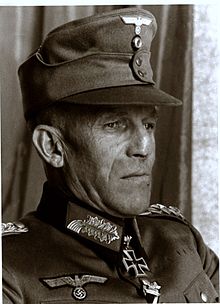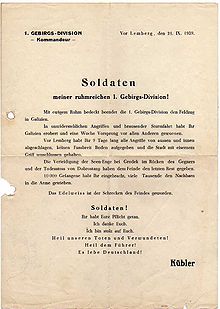This is an old revision of this page, as edited by Peacemaker67 (talk | contribs) at 02:30, 28 July 2016 (Reverted to revision 731870594 by K.e.coffman: Stop removing completely legitimate biographical information, please familiarsise yourself with how en WP does biographical articles. (TW)). The present address (URL) is a permanent link to this revision, which may differ significantly from the current revision.
Revision as of 02:30, 28 July 2016 by Peacemaker67 (talk | contribs) (Reverted to revision 731870594 by K.e.coffman: Stop removing completely legitimate biographical information, please familiarsise yourself with how en WP does biographical articles. (TW))(diff) ← Previous revision | Latest revision (diff) | Newer revision → (diff)
| This article includes a list of general references, but it lacks sufficient corresponding inline citations. Please help to improve this article by introducing more precise citations. (November 2012) (Learn how and when to remove this message) |
| Ludwig Kübler | |
|---|---|
 | |
| Born | (1889-09-02)2 September 1889 Munich, Kingdom of Bavaria |
| Died | 18 August 1947(1947-08-18) (aged 57) Ljubljana, Yugoslavia |
| Allegiance | |
| Service | Heer |
| Years of service | 1908–45 |
| Rank | General der Gebirgstruppe |
| Commands | 98th Mountain Regiment 1st Mountain Division XXXXIX Mountain Corps 4th Army LXXXXVII Army Corps z.b.V. |
| Battles / wars | World War I
World War II |
| Awards | Knight's Cross of the Iron Cross |
| Signature |  |
General Ludwig Kübler (2 September 1889 – 18 August 1947) was a German General of the Mountain Troops during World War II who was executed as a war criminal in Yugoslavia.
Early life
His father was the physician Wilhelm Kübler and he had six brothers and two sisters. In 1895 he enrolled in elementary school in Forstenried which he left after three years, he then attended the Gymnasium in Rosenheim and the humanist Ludwig Gymnasium in Munich. He graduated in 1908 with top grades and turned down a place at the prestigious Maximilianeum for a career in the military and joined the 15th Royal Bavarian Infantry Regiment "King Friedrich August of Saxony" as a cadet on 20 July 1908. From 1 October 1909 until 14 October 1910 he attended the War School in Munich at which he was placed fifth out of 166 students in his year. On 23 October 1910 he was commissioned as a leutnant.
First World War and the inter war period
At the beginning of the First World War he was serving with the 15th Royal Bavarian Infantry Regiment "King Friedrich August of Saxony" at the Western Front and was involved in September 1914 fighting in Lorraine and around St Quentin as commander of a machine gun platoon. On 24 September a serious injury from shell splinters left a conspicuous large scar on his face. Although the injury had not completely healed he returned on 13 January 1915 to his regiment, which took part in the Battle of the Somme. In his first months on the front Kübler earned the Iron Cross 1st and 2nd class (16 September and 17 November 1914). From 21 September 1915 he was the adjutant of his regiment and remained so for most of the war. On 18 August 1918 he was appointed a battalion commander in his regiment and promoted to the rank of Hauptmann. After the war he was retained in the Reichswehr. He was then a staff officer in the Army Department (T1) of Truppenamt for a few years. From 1925–1926 he was at the General Staff of Group Command 1 in Berlin. In the autumn of 1933 he was on the staff of the 7th Division of the Reichswehr in Munich and on 1 October 1934 was appointed the Chief of Staff of the VII Army Corps. On 1 June 1935 he was commander of the Mountain Brigade.
Second World War

At the start of World War II he was awarded the Knight's Cross of the Iron Cross for his role in the Polish campaign. Then on 1 December 1939 he was promoted to Generalleutnant. As commanding general of the new XXXXIX Mountain Army Corps he was earmarked to lead the cancelled conquest of Gibraltar (Operation Felix) and was then in the summer of 1941 involved in the attack in southern Russia and was transferred from General der Infanterie to General der Gebirgstruppe. He was then appointed commander of the 4th Army. His performance did not meet Adolf Hitler's expectations and he was moved to the leadership reserve and did not receive another command until the summer of 1943 and a year later he was appointed commander of LXXXXVII Army Corps. Shortly before the end of the war he was wounded and captured in Yugoslavia, where together with his successor Generalleutant Hans von Hößlin he was sentenced to death in 1947 by a Yugoslav court. He was hanged in Ljubljana on 18 August 1947, like his younger brother, Generalleutnant Joseph Kübler (1896–1947), who was also hanged in Belgrade on 26 February 1947.
In May 1964 the barracks in Mittenwald in Bavaria were named after General Kübler. In November 1995 Volker Rühe, then the German Minister of Defence, changed the name "General-Kübler-Kaserne" into "Karwendel-Kaserne".
Commands
- 1935 – 1936 98th Mountain Regiment
- 1936 – 1938 Mountain Brigade
- 1938 – 1940 1st Mountain Division (Poland and France)
- 1940 – 1941 XXXXIX Mountain Corps (Eastern Front)
- 1941 – 1942 4th Army (Eastern Front)
- 1942 – 1945 LXXXVII Mountain Corps (Yugoslavia)
Awards
- Iron Cross (1914)
- 2nd Class (16 September 1914)
- 1st Class (17 November 1914)
- Wound Badge (1914)
- in Black (7 June 1918)
- Military Merit Order, 4th class with Swords and Crown (Bavaria)
- Saxon Knight's Cross, 2nd Class of the Albert Order with Swords (12 May 1916)
- Honour Cross of the World War 1914/1918 (15 December 1934)
- Wehrmacht Long Service Award, 4th to 1st Class
- Anschluss Medal (21 November 1938)
- Clasp to the Iron Cross (1939)
- 2nd Class (15 September 1939)
- 1st Class (20 September 1939)
- Eastern Front Medal (23 August 1942)
- Knight's Cross of the Iron Cross on 27 October 1939 as Generalmajor and commander of 1. Gebirgs-Division
References
Citations
Bibliography
- Fellgiebel, Walther-Peer (2000) . Die Träger des Ritterkreuzes des Eisernen Kreuzes 1939–1945 — Die Inhaber der höchsten Auszeichnung des Zweiten Weltkrieges aller Wehrmachtteile (in German). Friedberg, Germany: Podzun-Pallas. ISBN 978-3-7909-0284-6.
{{cite book}}: Unknown parameter|trans_title=ignored (|trans-title=suggested) (help) - Scherzer, Veit (2007). Die Ritterkreuzträger 1939–1945 Die Inhaber des Ritterkreuzes des Eisernen Kreuzes 1939 von Heer, Luftwaffe, Kriegsmarine, Waffen-SS, Volkssturm sowie mit Deutschland verbündeter Streitkräfte nach den Unterlagen des Bundesarchives (in German). Jena, Germany: Scherzers Miltaer-Verlag. ISBN 978-3-938845-17-2.
{{cite book}}: Unknown parameter|trans_title=ignored (|trans-title=suggested) (help) - Thomas, Franz; Wegmann, Günter (1993). Die Ritterkreuzträger der Deutschen Wehrmacht 1939–1945 Teil VI: Die Gebirgstruppe Band 1: A–K (in German). Osnabrück, Germany: Biblio-Verlag. ISBN 978-3-7648-2430-3.
{{cite book}}: Unknown parameter|trans_title=ignored (|trans-title=suggested) (help)
| Military offices | ||
|---|---|---|
| Preceded bynone | Commander of 1. Gebirgs-Division 1 September 1939 – 25 October 1940 |
Succeeded byGeneral der Gebirgstruppe Hubert Lanz |
| Preceded bynone | Commander of XXXXIX. Gebirgs-Armeekorps 25 October 1940 – 19 December 1941 |
Succeeded byGeneral der Gebirgstruppe Rudolf Konrad |
| Preceded byGeneralfeldmarschall Günther von Kluge | Commander of 4. Armee 19 December 1941 – 20 January 1942 |
Succeeded byGeneraloberst Gotthard Heinrici |
| Preceded bynone | Commander of LXXXXVII. Armeekorps z.b.V. 28 September 1944 – 7 May 1945 |
Succeeded byGeneralleutnant Hans von Hößlin |
Template:Knight's Cross recipients of the 1st MD
Portal: Categories:- 1889 births
- 1947 deaths
- People from Munich
- People from the Kingdom of Bavaria
- Generals of Mountain Troops
- German military personnel of World War I
- Reichswehr personnel
- Executed military leaders
- Military personnel of Bavaria
- Executed people from Bavaria
- German people executed abroad
- People executed by Yugoslavia by hanging
- German people convicted of war crimes
- Recipients of the Knight's Cross of the Iron Cross
- Recipients of the clasp to the Iron Cross, 1st class
- Recipients of the Military Merit Order (Bavaria), 4th class
- Knights 2nd class of the Albert Order